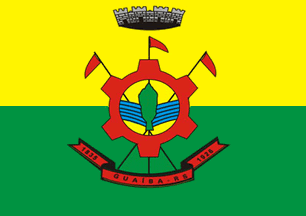 image by Dirk Schönberger,
16
February 2012
image by Dirk Schönberger,
16
February 2012Source: http://pt.wikipedia.org/wiki/Gua%C3%ADba

Last modified: 2012-03-29 by ian macdonald
Keywords: rio grande do sul | guaíba |
Links: FOTW homepage |
search |
disclaimer and copyright |
write us |
mirrors
 image by Dirk Schönberger,
16
February 2012
image by Dirk Schönberger,
16
February 2012
Source:
http://pt.wikipedia.org/wiki/Gua%C3%ADba
A horizontal bicolour, yellow over green with elements from the municipal arms in the centre.
Official website at
http://www.guaiba.rs.gov.br
Dirk Schönberger,
16 February 2012
The municipality of Guaíba (95,230 inhabitants in 2010; 377 sq. km) is located in the Porto Alegre Metropolitan Area, 30 km of Porto Alegre. Guaíba is named for Lake Guaíba, a name of Tupi-Guarani origin meaning "The Bay of All Waters", already written on maps from the 19th century (Guahyba).
Guaíba emerged as the village of Pedras Brancas (White Stones, referring to granitic formations, 600 millions years old, considered as among the oldest rocks on Earth), settled in the middle of the 19th century. People travelling from the south and west of Rio Grande do Sul to Porto Alegre crossed there Lake Guaíba, first on canoes, then on sailing boats, and, at the end of the 19th century, on steamboats. The estate granted in 1793 to Antônio Ferreira Leitão was inherited by his daughter Isabel Leonor, who married José Gomes de Vasconcelos Jardim (1773-1854). The leaders of the Farroupilha Rebellion gathered in the estate on the evening of 19 September 1835 to prepare the assault on Porto Alegre, which started the Rebellion; Gomes Jardim, leading 60 men, crossed Lake Guaíba to meet the troops commanded by Onofre Pires, stationed on the left bank of the lake. Recalling the historical event, the nickname of "Cradle of the Farroupilha Rebellion" was given to the town in the 1960s. Another Farroupilha hero, General Bento Gonçalves da Silva (1788-1847, 1st President of the Rio Grande do Sul Republic, 1836-18417, died in Gomes Jardim's estate. The municipality of Guaíba was established by State Decree No. 3,697 of 14 October 1926, merging the districts of Pedras Brancas, Barra do Ribeiro and Mariana Pimentel seceding from Porto Alegre.
The coat of arms shows on a yellow background a green tree on a green
terrace and a blue wavy base, surrounded by three spears each holding
a red pennant and a red cogwheel.
On the flag, the cogwheel is placed in the middle, over the three
spears; the wheel is filled with the tree over the blue waves.
http://www.guaiba.rs.gov.br/Conheca_Guaiba/bandeira_brasao.html
The blue waves stand for Lake Guaíba while the spears recall the
historical events that took place in Pedras Brancas during the
Farroupilha Rebellion. The tree is the Farroupilha Cypress, under
which Bento Gonçalves, Onofre Pires and Gomes Jardim planned the
assault on Porto Alegre.
http://www.flickr.com/photos/pedivela/122612270 - Photo of the cypress
Ivan Sache, 24 March 2012